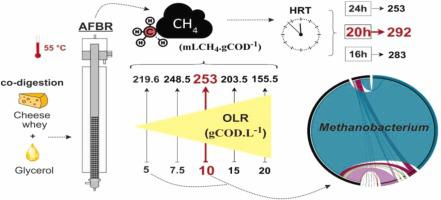Process Safety and Environmental Protection ( IF 6.9 ) Pub Date : 2022-07-25 , DOI: 10.1016/j.psep.2022.07.045 Priscilla de Souza Almeida , Camila Aparecida de Menezes , Franciele Pereira Camargo , Isabel Kimiko Sakamoto , Maria Bernadete Amâncio Varesche , Edson Luiz Silva

|
The organic loading rate (OLR) is one of the variables that directly affects anaerobic digestion. An increase in OLR can improve methane production, but it can also lead to process failures. Therefore, determining the proper OLR for the process is of great importance. This study analyzed the effect of increasing the OLR on cheese whey and glycerol co-digestion in a thermophilic anaerobic fluidized bed reactor (AFBR) by varying both the influent concentration and the hydraulic retention time (HRT). The increase in OLR from 5 to 20 gCOD.L-1.d-1 was initially performed by increasing the influent concentration from 5 to 7.5, 10, 15, and 20 gCOD.L-1, at HRT of 24 h. Organic matter removal (87.7%), methane yield (MY) (253.0 mL CH4.gCOD-1rem), and methane production rate (MPR) (3.2 L CH4.L-1.d-1) showed the best performance at 10 gCOD.L-1.d-1. Conversely, raising the OLR to 20 gCOD.L-1 enhanced the buildup of volatile fatty acids, resulting in a 38.5% decrease in MY. Based on these findings, the HRT was reduced from 24 h to 20 h and 16 h at influent concentration of 10 gCOD.L-1 resulting in OLR of 10, 12, and 15 gCOD.L-1.d-1, respectively. The HRT at 20 h (12 gCOD.L-1.d-1) provided the highest MY values (around 292.5 mL CH4.gCOD-1rem), while the maximum MPR was observed at 16 h (5.1 L CH4.L-1.d-1). The main metabolites observed in all conditions were acetic acid (31.1 - 66.8%) and propionic acid (10.9 - 61.5%). The OLR also affected the microbial community, with Proteobacteria accounting for 53.1% of the relative abundance at 5 gCOD.L-1.d-1 while Firmicutes accounted for 76.6% at 10 gCOD.L-1.d-1. At 10 gCOD.L-1.d-1, with maximum MY, the bacteria observed with the highest relative abundance were an unidentified genus of Lentimicrobiaceae (8.9%), “Blvii28 wastewater sludge group” (2.9%), and Tolumonas (1.4%). The archaea identified with the highest relative abundance at both OLRs (5 and 10 gCOD.L-1.d-1) was hydrogenotrophic Methanobacterium (27.3% and 2.6%, respectively).
中文翻译:

甘油和奶酪乳清的嗜热厌氧共消化 - 增加有机负载率的影响
有机负荷率 (OLR) 是直接影响厌氧消化的变量之一。OLR 的增加可以提高甲烷产量,但也可能导致工艺故障。因此,为流程确定合适的 OLR 非常重要。本研究通过改变进水浓度和水力停留时间 (HRT),分析了增加 OLR 对嗜热厌氧流化床反应器 (AFBR) 中奶酪乳清和甘油共消化的影响。OLR 从 5 增加到 20 gCOD.L -1 .d -1最初是通过在 24小时的 HRT 下将进水浓度从 5 增加到 7.5、10、15 和 20 gCOD.L -1来实现的。 有机物去除 (87.7%),甲烷产率 (MY) (253.0 mL CH4 .gCOD -1 rem ) 和甲烷产率 (MPR) (3.2 L CH 4 .L -1 .d -1 ) 在 10 gCOD.L -1 .d -1时表现出最佳性能。相反,将 OLR 提高到 20 gCOD.L -1会增强挥发性脂肪酸的积累,导致 MY 下降 38.5%。基于这些发现,当进水浓度为 10 gCOD.L -1 时,HRT 从 24小时减少到 20 小时和 16小时,导致 OLR 分别为 10、12 和 15 gCOD.L -1 .d -1。20小时 HRT (12 gCOD.L -1 .d -1 ) 提供了最高的 MY 值(大约 292.5 mL CH 4 .gCOD -1 rem),而在 16 小时观察到最大 MPR(5.1 L CH 4 .L -1 .d -1)。在所有条件下观察到的主要代谢物是乙酸 (31.1 - 66.8%) 和丙酸 (10.9 - 61.5%)。OLR 也影响微生物群落,在 5 gCOD.L -1 .d -1时变形菌占相对丰度的 53.1%,而在 10 gCOD.L -1 .d -1时厚壁菌门占 76.6% 。在 10 gCOD.L -1 .d -1,在最大 MY 下,观察到的相对丰度最高的细菌是 Lentimicrobiaceae (8.9%)、“Blvii28 废水污泥组”(2.9%) 和Tolumonas (1.4%) 的未知属。在两种 OLR(5 和 10 gCOD.L -1 .d -1)中鉴定出相对丰度最高的古细菌是氢营养甲烷杆菌(分别为 27.3% 和 2.6%)。











































 京公网安备 11010802027423号
京公网安备 11010802027423号